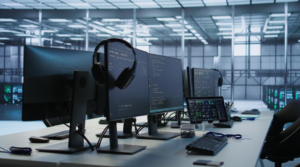How Does Avantari Use AI Tools to Design Hardware Smarter and Faster?

In today’s fast-paced hardware design era, speed, accuracy, and innovation are not a luxury but a necessity. Be it consumer electronics or industrial embedded systems, the sophistication of hardware today calls for new-age design approaches. This is where AI tools have become game changers, allowing engineers and designers to work smarter instead of harder.
Avantari, a leader in AI-based hardware design, is leading the way for the adoption of artificial intelligence within hardware design methodologies. Through sophisticated AI tools, Avantari speeds up design time, increases accuracy, saves costs, and produces next-generation hardware solutions quicker than ever.
So, just how is Avantari using ai tools for hardware design? Let’s take a look.
The Increasing Demand for AI in Hardware Design
Hardware design in the past has been labor-intensive and time-consuming, with tedious iterations done manually, serious testing, and repeated prototyping. As devices become increasingly complex, the error margin decreases, and the need for accelerated time-to-market increases.
AI addresses these issues by:
Automation of repetitive tasks such as routing and layout optimization
The ability to predict design faults prior to manufacture
Component placement optimization for improved performance
Power consumption reduction using smart algorithms
Simulation of multiple scenarios within minutes, not weeks
Avantari realized soon that AI-based workflows have the potential to significantly lower design cycles with enhanced quality.
How Avantari Incorporates AI Tools into Hardware Design
Avantari has a complete approach, fusing AI-enabled software and domain knowledge. Let’s see how they incorporate AI at all phases of the hardware design life cycle.
1. AI-Powered Concept Generation
Prior to actual design, Avantari applies AI-enabled simulation tools to:
Analyze design needs
Create optimized hardware architecture
Identify potential bottlenecks
This enables their engineers to begin with the optimal blueprint, eliminating weeks of manual planning.
2. AI in PCB Layout & Routing
Printed Circuit Board (PCB) design is usually one of the most difficult aspects of hardware development. Avantari uses AI tools that:
Optimizes trace routing automatically
Ensures signal integrity and EMI reduction
Recommends optimal component placement for thermal management
Not only saves design time but also increases overall reliability of the hardware.
3. Generative Design for Mechanical Parts
For thermal solutions, casings, and enclosures, Avantari employs AI-driven generative design software. These software try out thousands of design combinations and suggest lightweight, affordable, and robust structures.
This yields novel but manufacturable hardware designs with a balance of aesthetics and functionality.
4. AI-Powered Simulation & Testing
Rather than making an infinite number of physical prototypes, Avantari uses AI-driven digital twins and simulation software.
Thermal simulations forecast overheating danger
Stress tests mimic conditions in the real world
Reliability analysis identifies weak points before production
This drastically cuts down the prototype iteration cycle, saving time and cost.
5. Predictive Maintenance & Lifecycle Management
Even after the hardware is designed, Avantari uses AI for predictive analytics, ensuring:
Improved component lifespan
Early detection of potential failures
Smarter updates for long-term reliability
This makes their hardware solutions future-ready and sustainable.
Real-World Impact: Faster, Smarter, Better
Avantari’s AI-driven approach results in:
50% faster design cycles
Reduced cost of production because of fewer errors
Greater performance and efficiency in end products
Scalable solutions that evolve with new technologies
From consumer electronics, IoT devices, to industrial hardware, Avantari provides innovation without sacrificing quality.
Why AI in Hardware Design is a Game Changer
Here’s why businesses are implementing AI tools for hardware design:
Faster time-to-market – AI eliminates manual effort and testing.
Enhanced design accuracy – AI spots errors humans might miss.
Cost savings – Fewer prototypes, fewer design iterations.
Better product performance – AI finds the most optimized designs.
Future-proofing – AI learns and improves with every project.
Avantari combines these AI advantages with deep engineering expertise, ensuring the best of both worlds—human creativity and machine intelligence.
Industries Benefiting from Avantari’s AI Hardware Design
Avantari serves a diverse range of industries, including:
Consumer Electronics – Smart wearables, devices, and home automation
Automotive – Advanced driver assistance systems (ADAS) and infotainment hardware
Healthcare – Medical devices and diagnostic imaging hardware
Industrial Automation – Robotics, sensors, and embedded controllers
Telecommunications – High-performance networking hardware
With AI incorporated, Avantari customizes designs to industry-specific needs, with reliability and adherence to international standards.
The Future of AI in Hardware Development
AI in hardware design is only starting. Avantari is already looking into:
AI + Quantum Computing for even faster simulations
AI-driven 3D printing workflows for rapid prototyping
Machine learning algorithms that predict real-world performance
This continuous innovation ensures Avantari stays ahead in delivering next-generation hardware solutions.
FAQs on Avantari’s AI-Driven Hardware Design
1. What AI tools does Avantari use for hardware design?
Avantari uses a mix of AI-based PCB design tools, generative design software, and digital twin simulations for complete hardware optimization.
2. Does AI completely replace human engineers?
No. AI assists designers by automating repetitive tasks and providing intelligent recommendations, while human engineers make critical design decisions.
3. Can Avantari redesign existing hardware using AI?
Yes. Avantari can audit and optimize existing hardware, improving efficiency and reducing costs using AI-driven analysis.
4. How does AI reduce hardware development time?
AI automates routing, layout, and simulation, eliminating multiple manual iterations and accelerating prototyping and testing phases.
5. Is AI-driven hardware design more expensive?
Initially, it may require investment in AI tools, but in the long run, it reduces overall costs by minimizing errors and time-to-market.
Final Thoughts
The world of hardware design is changing, and AI tools are at the forefront of this change. Avantari is one such pioneer that uses AI, advanced simulations, and deep engineering knowledge to develop hardware products that are intelligent, quicker, and more dependable.
By adopting AI-driven methodologies, Avantari helps businesses achieve innovation at scale, ensuring high performance and reduced time-to-market for next-gen hardware.
If you’re looking to future-proof your hardware design process, partnering with Avantari could be the game-changing move your business needs.



